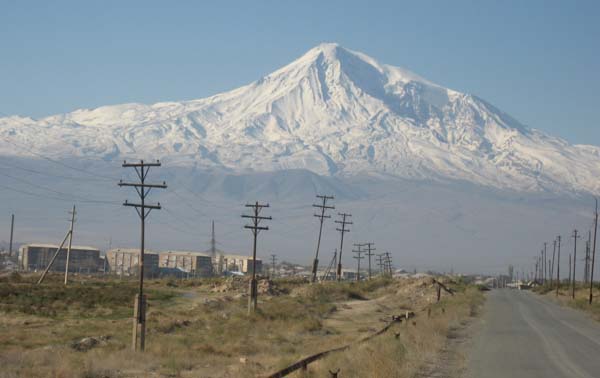Conflicts fuel Caucasus climate fears
The melting snows of Mount Ararat are a stark warning of growing problems in a fragile region so fragmented by conflict that unified efforts to address climate change are severely restricted
By Climate news Network: ARMENIA, 25 June − Mount Ararat, the 5,137-metre outcrop on which some believe Noah and his Ark survived the great flood, is a symbol of identity to many millions of Armenians. It has also become a symbol of conflict − and its warming climate is a likely harbinger of change to come in the region.
The mountain is not in Armenia but in Turkey, its conical, snow-covered peak visible across a closed and heavily-militarised border. But now Ararat’s snows − seen all year round, even when summer temperatures reach nearly 40C on the plains below – are melting.
A 2012 study by Turkish geologists, published in the Journal of Asian Earth Sciences, found that Ararat’s glaciers declined in size by nearly 30% between 1976 and 2008. It concluded that a rise in temperatures on the mountain, coupled with a fall in precipitation, were the likely causes of the glacial reduction.
Erratic rainfall
Further north, in the Caucasus mountains, there’s a similar story. The Earth Policy Institute calculates that glacial volume in the Caucasus has decreased by 50% over the last century, with particularly sharp declines in ice cover over the last 20 years. Across the region, summer temperatures are increasing, while rainfall patterns are becoming increasingly erratic.
However, regional rivalries and conflicts among the nations of the Caucasus make any unified approach to addressing these problems extremely difficult.
Landlocked Armenia, with a population of just over three million, has no official relations either with Turkey, to the west, or Azerbaijan, to the east. Georgia, with its population of four and half million, recently went to war with its northern neighbour Russia over the disputed territory of South Ossetia.
Diana Harutyunyan, one of Armenia’s negotiators at UN climate meetings and also a UN Development Programme climate change co-ordinator, says: “Armenia and countries in this region, with their semi-arid climates and fragile ecosystems, are extremely vulnerable to climate change.
“One of the key problems is that we don’t have a common voice and don’t really make ourselves heard; we are not a grouping, but tend to act individually.
“Not only are we seeing a clear downward trend in precipitation and a rise in temperatures in many areas, but also there’s increasing desertification − caused not just by changes in climate but by the wholesale chopping down of trees.
“All of this has major economic implications, but, to be honest, this region is not very active, and there is a serious lack of research and data. For example, none of the countries in the region have statistics on climate change and its impact on public health.”
Little co-operation
When the Caucasus region formed part of the Soviet Union, climate data collection was carried out on a region-wide basis; now it is done by each individual country, with varying standards and little cross-border co-operation.
The break-up of the USSR in the early 1990s had other consequences. Much of the heavy industry in the Caucasus collapsed as state subsidies were removed. As a result, emissions of greenhouse gases fell dramatically, particularly in Georgia and Armenia, as shown in a 2011 report by the Environment and Security Initiative, the UN Environment Programme and others.
Land was removed from state control after the collapse of the USSR, but experts say that agriculture in much of the region is now in crisis as farmers struggle to cope without any state help. Recent freak hail storms, which destroyed crops, mean that more people are leaving the land to seek jobs in cities or abroad.
“Climate change is just one more problem that the mainly agricultural economies in this region are facing,” Harutyunyan says.
“We are going to have to adapt, but there is still a lot of scepticism. Many say there are too many uncertainties. I tell them that uncertainty cannot be an excuse for inaction.” − Climate News Network
